“Cute” in Japanese: Understanding “Kawaii” Culture in Japan (With Example Phrases)
Are you interested in Japanese anime, manga, fashion, or culture? Then you’ll be sure to come across かわいい (kawaii) culture, which is anything “cute” in Japanese language and context.
In fact, cuteness is so ingrained in Japanese culture that you see it everywhere in all kinds of forms — from guro-kawaii (“gross-cute”) to kimo-kawaii (“scary-cute”).
Mascots for most brands are designed to be kawaii. Japanese pop groups dress, talk, and act kawaii. Harajuku has so many sub-fashions of kawaii dress that it’s taken on a life of its own.
So if you’re going to learn Japanese, you have to understand Japanese cute culture — and master some cute Japanese words.
Table of contents
- “Cute” in Japanese – Kawaii
- Cute Japanese Words
- Kirei – “Beautiful” or “Clean”
- Dokidoki – Heart beating
- Kurakura – “Dizzy” or “Giddy”
- Fuwafuwa – “Fluffy”
- Kirakira – “Sparkling” or “Glittering”
- Pikapika – “Shiny”
- Yokatta – “I’m Glad” or “Yay!”
- Tanoshii – “Enjoyable” or “Cheerful”
- Ureshii – “Happy”
- Wanwan and Nya-nya- – “Dog” and “Cat”
- Ne – “Right?”
- Jan – “Isn’t it?”
- Referring to Yourself in Third Person
- Kawaii: Cute Culture in Japan
- Kawaii Fashion
- Kawaii Anime: Magical Girl Archetype
- It’s Okay, Let Your Kawaii Self Shine
Let’s bring out our inner kawaii!
“Cute” in Japanese – Kawaii
可愛い (kawaii in kanji) means “cute” in Japanese, though its also often written only in hiragana as かわいい (kawaii). But the meaning of “kawaii” can change based on context.
Sometimes it means anything “small” and “loveable”. Other times it means “lovely”, “child-like” or even “shy.” Really, it represents any cute “kawaii” persona.
There are whole genres of anime and manga designed to fit this persona, like CardCaptor Sakura, Madoka Magica, and of course, the legendary Sailor Moon.
And besides shoujo anime kawaii vibes, there are also kawaii characters in most other shows too, especially for kids. Like Doraemon, Pikachu, and Hello Kitty.
Cute Japanese Words
Besides かわいい (kawaii), there are some other cute Japanese words you should know to sound cute in Japanese.
Keep in mind, almost anything can sound cute in Japanese, and a lot of the time it comes down to how you say the word. Drawing out the final vowel sound, saying it in a nasal or high-pitched way, or adding cute “endings” to the words are all ways to make them sound “cuter.”
Kirei – “Beautiful” or “Clean”
きれいな (kirei na) is an adjective meaning something is “beautiful” or “clean.” You can drop the な (na) when using it on its own to exclaim “きれい!”
But if you’re attaching it to a noun, like to say a woman is beautiful, you’d say: きれいな女性 (kirei na josei).
Dokidoki – Heart beating
ドキドキ (dokidoki) is a Japanese onomatopoeia used to describe the sound of a heart beating fast. You’ll often see this in manga written next to a person whose heart is beating fast and blushing from being near their crush.
You can also attach the verb する (suru, “to do”) and say ドキドキする (dokidoki suru) — “my heart’s beating fast!”
Kurakura – “Dizzy” or “Giddy”
クラクラ (kurakura) is another onomatopoeia meaning “dizzy” or “giddy” with happiness. You can use it to express that you’re so happy and excited or that your head is spinning.
You can also pair it with する (suru) to make it a verb.
Fuwafuwa – “Fluffy”
Another cute Japanese word is フワフワ (fuwafuwa) which describes something as “fluffy”. Use this with things like a fluffy pillow, a soft blanket, or a fluffy cat.
Kirakira – “Sparkling” or “Glittering”
キラキラ (kirakira) means something is “sparkling” or “glittery.” So many cute things are described as キラキラ.
Fun fact: If you type キラキラ with a Japanese keyboard, the emoji ✨ is suggested because it’s ~glittering~.
Pikapika – “Shiny”
Yes, like the Pokemon! ピカピカ (pikapika) means “shiny” like a spark.
A lot of Japanese onomatopoeia are used to sound cute or describe things in a cute way, so you’ll hear them often.
Yokatta – “I’m Glad” or “Yay!”
良かった (yokatta in kanji) is past tense of いい (ii), the irregular adjective that means “good.” So 良かった can mean something “was good.”
But as an exclamation or reply, usually written only in hiragana as よかった (yokatta), it means “That’s great!” or “I’m glad!” It’s also used like “yay” when you exclaim with joy.
Tanoshii – “Enjoyable” or “Cheerful”
楽しい (tanoshii) has many different meanings, from “pleasant” to “happy” to “enjoyable.” It’s often used to say something is or was fun.
You can also use the phrases 楽しみにしてる (tanoshimi ni shiteru) or 楽しんで (tanoshinde) in casual situations. The first means “I’m looking forward to it” and the latter means “Enjoy!”
Ureshii – “Happy”
嬉しい (ureshii) is used to say you’re “happy” or “glad.” Girls will often exclaim this when something good is happening or when they’re happily surprised.
Wanwan and Nya-nya- – “Dog” and “Cat”
So, technically, ワンワン (wanwan) and ニャーニャー (nya-nya-) are the onomatopoeia sounds a dog and cat make respectively.
But kids often call dogs ワンワン (wanwan) instead of 犬 (inu), and sometimes cats ニャーニャー (nya-nya-) instead of 猫 (neko).
Even though this is usually something kids say, sometimes teens and women say it too to sound cute.
Ne – “Right?”
ね (ne) is a sentence-ending particle used to say “right?” But it’s also used to soften a sentence and sound cuter.
For example, かわいいね! (kawaii ne!) means “Cute, right?” You could leave off the ne but it adds extra cuteness.
Jan – “Isn’t it?”
A contraction of じゃない (ja nai) and only used in informal situations. じゃん is used at the end of sentences much like ne to say “isn’t it?”
For example, とってもかっこいいじゃん (tottemo kakkoii jan) means “It’s SO cool, isn’t it?”
The contraction sounds more casual, and girls often use it to sound cuter.
Referring to Yourself in Third Person
And lastly, if you want to sound めっちゃかわいい (meccha kawaii, “super cute”), refer to yourself in the third person.
Yup, instead of saying “I”, use your name to talk about yourself! This is supposed to sound more “child-like” and cute, and a lot of young adult women do this.
A warning though: some people find this a bit obnoxious.
Kawaii: Cute Culture in Japan
There are four main themes that tend to pop up in Japanese culture: kawaii (“cute”), youkai (“ghosts”), mecha, and apocalyptic themes.
There’s a bunch of reasons these trends pop up a lot. But kawaii culture is definitely one of the most prominent because it even overlaps into the other 3 categories.
For example, there are different levels of kawaii, such as kimo-kawaii, which is “scary-cute.” Think like cute Ghost-type Pokemon:
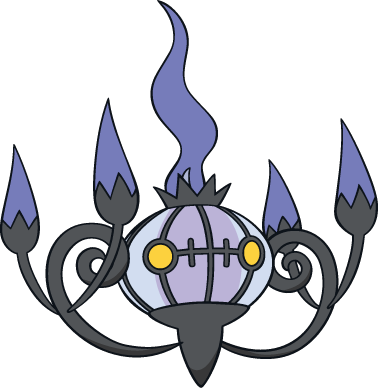
There’s also busu-kawaii or guro-kawaii which mean “ugly” or “gross” cute. J-Pop idol Kyary Pamyu Pamyu is a famous example of using guro-kawaii to set trends.
An old school manga, Rave Master, often had many busu-kawaii characters:
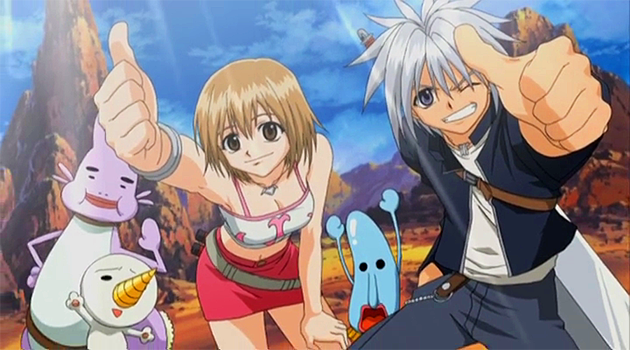
And there’s ero-kawaii, which is things like maids and catgirls. There are also some more risque J-Pop idols like Koda Kumi who have made their name being ero-kawaii:
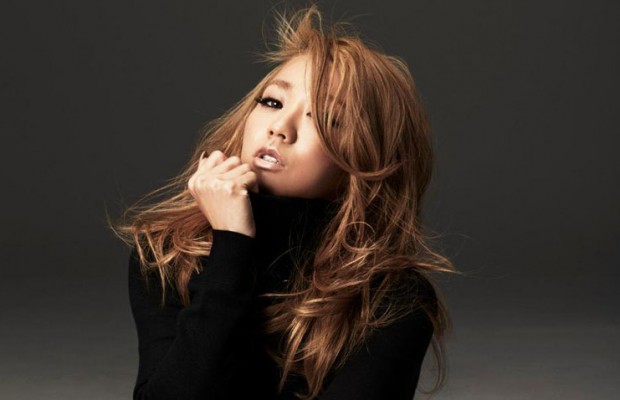
You’ll see kawaii culture everywhere in Japan because “cuteness” is thought of as pure, attractive, and happy.
Announcements and sounds are often in cute tones. Chibi mascots are everywhere and social media is filled with kawaii emojis.
You can even see how kawaii culture has permeated into Western society too. One of the mega video game hits of 2020 was Animal Crossing, largely due to its easy-going gameplay and cute, happy designs.
Kawaii also has strong ties to schoolgirls, specifically school uniforms and handwriting. A lot of school uniforms in Japan are seen as “kawaii” and fashion. (This has its own issues, though, as I’m sure you can imagine.)
Some girls also write with a more “rounded” script, called “kitten writing”, to look softer.
Sometimes excessive cuteness is referred to as burikko, which is someone who uses cuteness as a mask and it comes off a bit fake.
Kawaii Fashion
You can’t talk about kawaii culture without talking about kawaii clothes. Cute fashion is a huge part of Japanese culture, especially in the street district of Harajuku in Tokyo, Japan.
If you’re a Gwen Stefani fan, you may remember she took heavy inspiration from her No Doubt days in Japan where she loved exploring the fashion in Harajuku. Same with Nicki Minaj who’s called herself the “Harajuku Barbie” and often wears Japanese street style fashion.
There are tons of sub-culture styles that often tend to take on a whole personality, too. Some of the biggest ones are decora, sweet lolita, gothic lolita, gyaru, mori kei, fairy kei, and visual kei.
Visual kei is the gothic, androgenous style from the 80’s and mid-90’s, probably best known from artists like Dir en grey and L’Arc~En~Ciel.
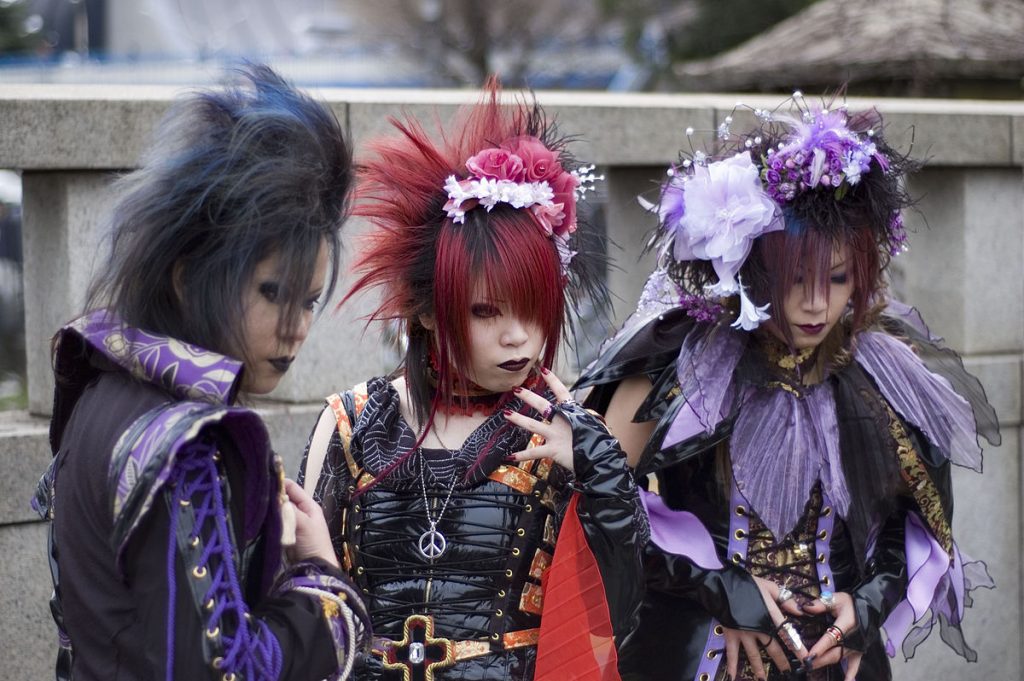
Lolita fashion is often the Victorian-era inspired kawaii dress. There’s a lot of sub-sets to lolita fashion, but the two main ones are sweet and gothic. It’s usually frilly dresses, blouses, petticoats, and knee socks.
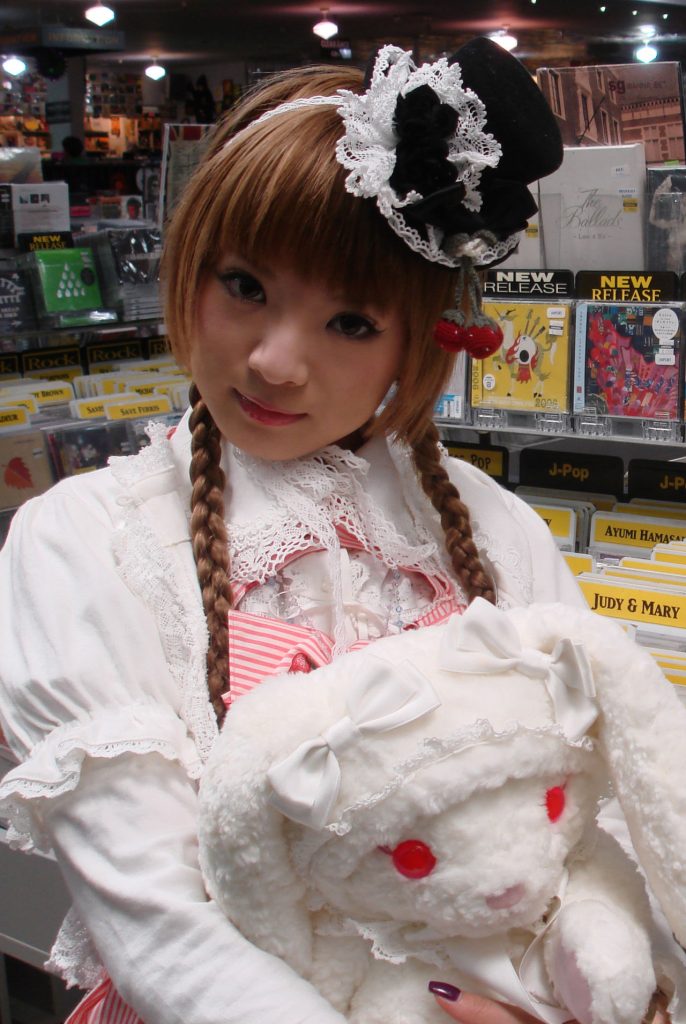
Decora is a huge fashion trend with super bright rainbow-colored outfits and loads of cute accessories and pompoms.
[decora.jpg]
Gyaru fashion is often an exaggeration of Western fashion trends. Lots of over-tanning, big hair (usually blonde), and over-contoured makeup.
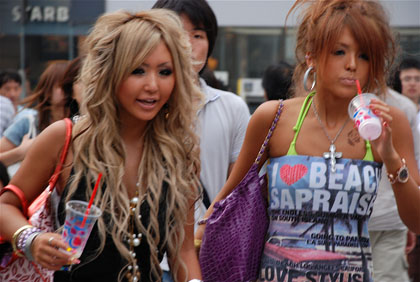
Lastly, fairy kei is like a pastel mix of decora and lolita, with tons of pinks, purples, blues, and baby doll-style clothes. Mori kei uses soft, neutral colors, lots of layers, and dresses.
Kawaii Anime: Magical Girl Archetype
Kawaii girls in anime and kawaii drawings have had a huge impact on Japanese society.
Kawaii culture didn’t start from anime. But it definitely became more popularized in the 80’s and 90’s due to mega-hits like Sailor Moon, which started the shoujo (girl’s) manga trend of cute Magical Girl archetypes. (Also called 魔法少女, mahou shoujo, in Japanese.)
Shoujo became full of magical girl characters and themes after that. From CLAMP novels to Tokyo Mew Mew and even Hayao Miyazaki films, like Kiki’s Delivery Service.
These stories base the character around kawaii aspects, with frilly, cute outfits, colorful hair, and huge eyes. Sailor Moon set the trend and many have followed after: most magical girl shows include a transformation scene.
And you can’t forget Hatsune Miku, a hologram K-Pop star who combined kawaii and tech culture with magical girl elements.
Of course, there are other less magical shoujo anime and manga, too. Like Fruits Basket, Lovely Complex, Kare Kano, and K-On!
Even in shonen (“boy’s”) comics, you can’t escape kawaii characters. Shows like One Piece have some guro-kawaii and ero-kawaii characters, too.
But anime and manga became so popular around the world, in part, because of its obsession with all things kawaii which we just don’t have in the West to the same level.
It spread the otaku (“mega-fan”) vibes all over the world.
It’s Okay, Let Your Kawaii Self Shine
Go ahead, enjoy all things cute in Japanese — we won’t judge! It’s hard to resist so much cuteness when it’s everywhere in Japanese culture!
And if you’re up for your next Japanese language mission, you could learn some Japanese proverbs or learn beautiful Japanese words and expressions next.

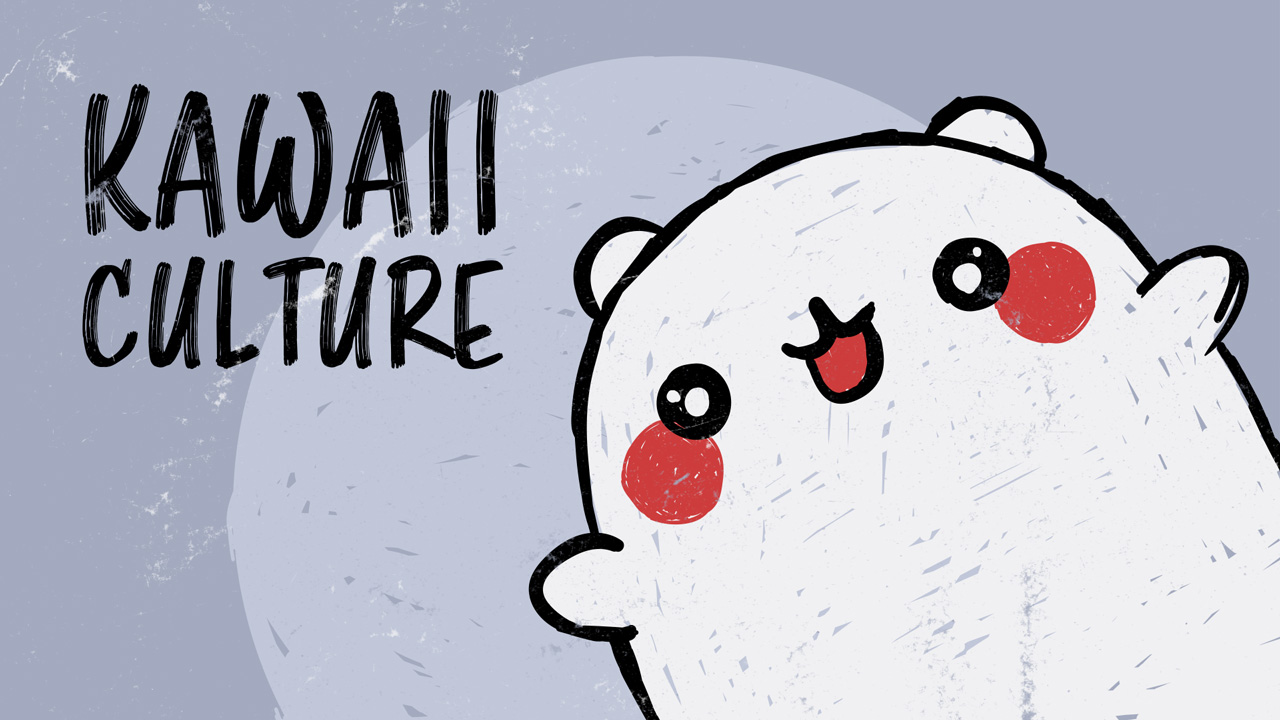
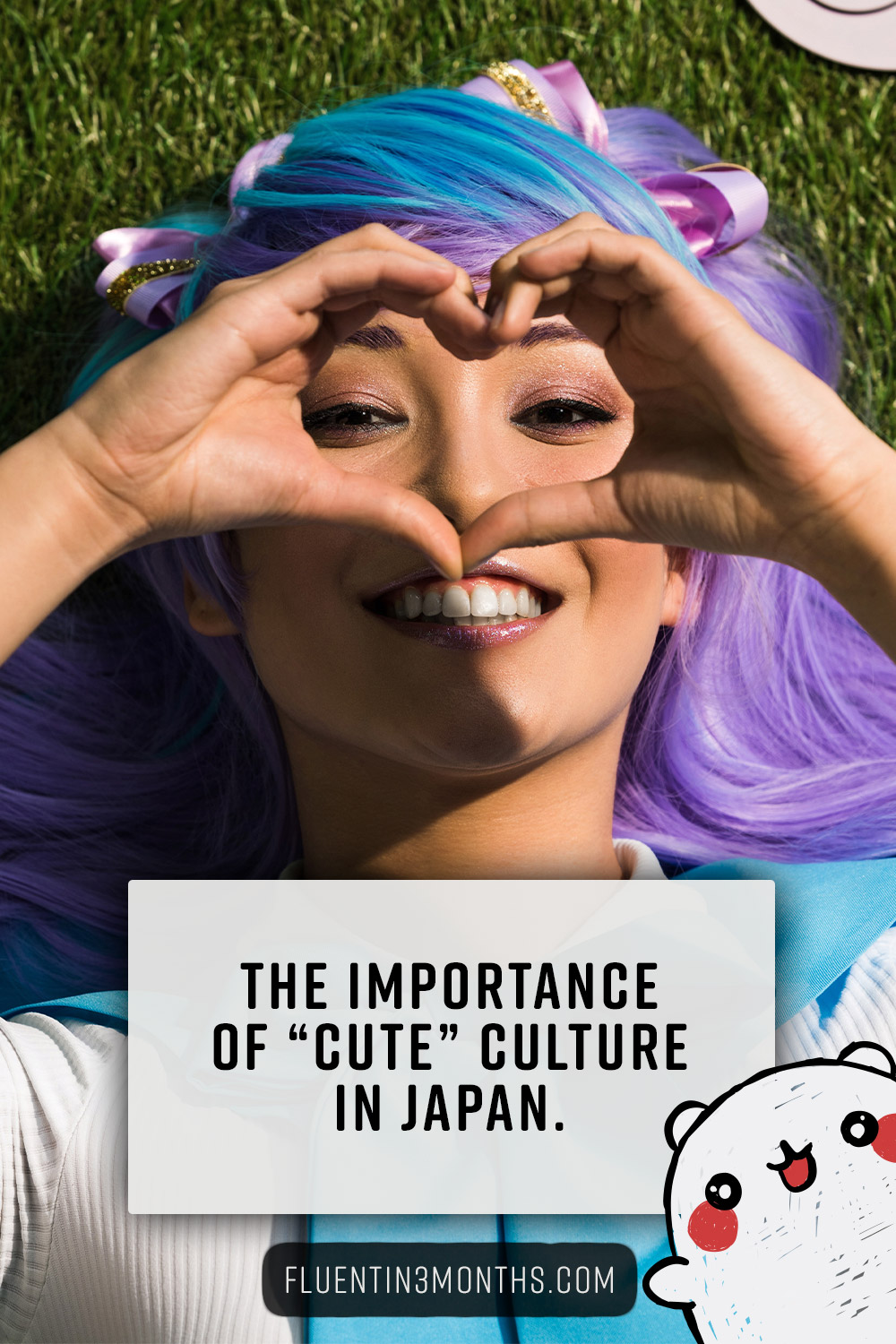

Social